


Framed or unframed, desk size to sofa size, printed by us in Arizona and Alabama since 2007. Explore now.
Shorpy is funded by you. Patreon contributors get an ad-free experience.
Learn more.

- Baldwin 62303
- Baldwin VO-1000
- Cold
- No expense spared
- Tough Guys
- Lost in Toyland
- And without gloves
- If I were a blindfolded time traveler
- Smoke Consumer Also Cooks
- Oh that stove!
- Possibly still there?
- What?!?
- $100 Reward
- Freeze Frame
- Texas Flyer wanted
- Just a Year Too Soon
- WWII -- Replacing men with women at the railroad crossing.
- Yes, Icing
- You kids drive me nuts!
- NOT An Easy Job
- I wonder
- Just add window boxes
- Icing Platform?
- Indiana Harbor Belt abides
- Freezing haze
- Corrections (for those who care)
- C&NW at Nelson
- Fallen Flags
- A dangerous job made worse
- Water Stop
Print Emporium
Northward Ho: 1905
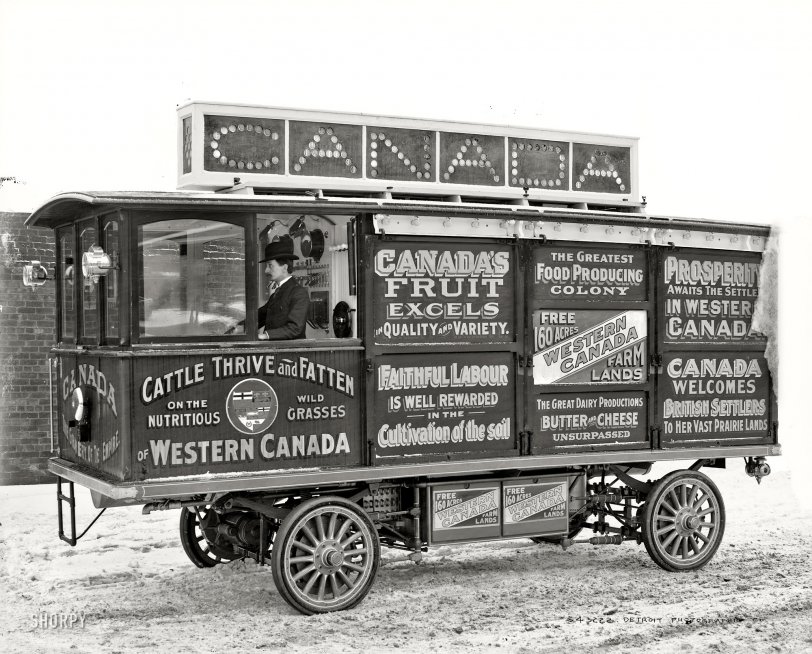
Circa 1905. "Motor car, Canadian Government Colonization Co." I wonder if there was a calliope aboard, or bagpipes. Detroit Publishing Company. View full size.
CPR Archives response
I received an email this morning from the CPR Archives...
The photo of the motor car is interesting and new to us. The CP exhibit car was a railway car promoting farming in western Canada (see photos NS16354 and NS12974). CP also had a "trailer" which was hauled in Europe (see NS11550 in Paris)."
I also came across this, which is unfortunately unaccessible in its entirety without purchasing the book.
In my reply to the archivist, I cited the posting earlier by Jimmytruck.
Curiouser and curiouser.
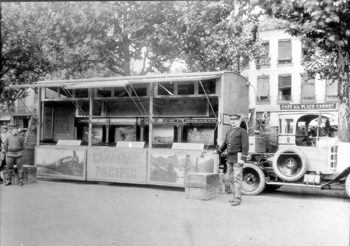
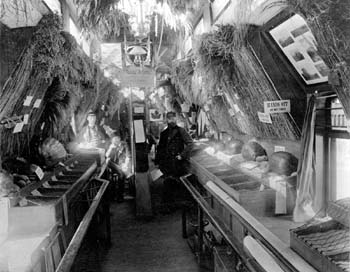
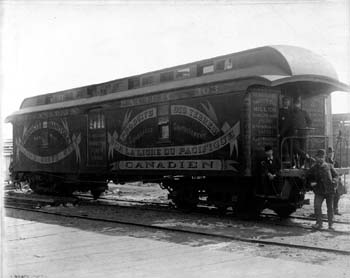
Similar to the Homestead Act
The promise on the wagon of 160 free acres reminds me of the promises of the American Homestead Act that promised anyone 160 free acres of land if they stayed on (and improved) the land and stayed for 5 years. In the corner of the prairie where I grew up (NW Iowa) my ancestors and lots of people made it, but lots of people didn't make it in the wilds of South and North Dakota. I can't even imagine how you could make it in a sod hut or tiny cabin even further north in the winters of Western Canada. All of those pioneers were made of sterner stuff!
The CPR and Western Immigration
The Canadian Pacific Railway was instrumental in promoting immigration to Canada and settling the western provinces, in particular.
1905 was a pivotal year because that was the formation of the provinces of Saskatchewan and Alberta. Since the CPR had the only available transportation method of getting settlers into these new provinces, and they had a vested interest in encouraging both the agricultural future and the urban future of the west, they made it their business to encourage settlement. Since they also had a vested interest in getting settlers from Europe via their steamship line, they were VERY interested in advertising both the method and the reason for getting to Canada.
They advertised in the form of lectures and through films (William Van Horne hired film maker James Freer to film all aspects of Canada (discouraging the use of winter scenes)
"James Freer, who began shooting scenes of Manitoba farm life in 1897, and who was being sponsored on tours of Britain by William Van Horne as early as April 1898, was a pioneer in every sense of the word. None of his films appear to have survived, but his promotional literature indicates the eclectic nature of his offerings, part hard sell and part general-interest subjects to attract the audience. Entitled "Ten years in Manitoba -- 25,000 instantaneous photos upon half-a-mile of Edison films," a typical Freer "cinematograph lecture" included Arrival of CPR Express at Winnipeg, Harnessing the Virgin Prairie, Harvesting Scene with Trains Passing and Winnipeg Fire Boys on the Warpath. The first tour was evidently considered both a popular and a commercial success, though its immediate impact on emigration figures cannot be calculated. In 1901 Clifford Sifton, then minister of the Interior, agreed to sponsor a second one "under the auspices of the Canadian Government." This 1902 tour, using the same program of films, was less successful than the first, and neither the CPR nor the federal government was prepared to sponsor a third."
http://www.collectionscanada.gc.ca/publications/archivist-magazine/01500...
A joint effort between the CPR and the Canadian government IN THE WESTERN US STATES featured an "exhibition van" "which travelled the highways and country roads, much after the fashion of the van used in England by the railway company. The car was in charge of L.O. Armstrong, an effective speaker who represented the railway.
According to the same book, "Building the Canadian West - The Land and Colonization Policies of the Canadian Pacific Railway (cited above), there was a colonization company (Beiseker and Davidson) active in the western US states and eventually brought 23 settlers from Colorado to found the Bassano Colony, in Alberta. This was in 1914.
http://books.google.ca/books?id=CxsA_rOLK1UC&lpg=PA113&ots=2geF2e37ks&dq...
No description of the van is given. I have contacted the CPR Archives to see if I can find out more. The automated response tells me that I can expect to wait 6-8 weeks for an initial response... Great.
Comedy Imitates Life
In his album "Stan Freberg Presents the United States of America, Part 2" the founding fathers invent a new medium called Tele-wagon. It would be pulled around Europe while people extolled the new country's virtues through a small hole cut in the side. I wonder if Mr. Freberg knows how close to reality he came with his seemingly-goofy idea.
Northern Lights
I'm hoping the lighted letters on top worked thusly: each letter lights up in turn (C-A-N-A-D-A), and then the entire word flashes several times ("CANADA" "CANADA" "CANADA"!). That would have been all kinds of awesome!
Wondering no more
I always wondered what possessed the various branches of my family to come to Canada. Now I know!
Filling the Promised Land
At this time Canada was enthusiastically promoting immigration. Here's another 1905 promotional wagon, somewhat less hi-tech.
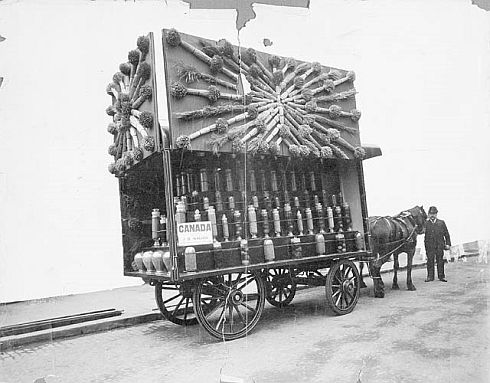
Early day hybrid
According to "The Golden Years of Trucking" published by the Ontario Trucking Association in 1976, this was a gas-electric four-wheel-drive truck built by the Commercial Motor Vehicle Co. of Windsor, Ontario. It had an electric motor on each wheel, was 20 feet long and had an 81-inch track. The four cylinder engine produced 20 HP. The truck was sent to England to visit "every town and village in the country." Because it was so underpowered it never made it out of London. Presumably it was left in England.
The sides could be hinged up to expose examples of the wonderful Canadian produce.
[Fabulous. One question: When? - Dave]
The temperature
When our Fellowship sponsored a family of Kosovar refugees during the war in the former Yugoslavia, we were trying to impress upon them that the winters were "very, very cold".
After bringing this up a number of times, the father finally said "If the winters were that cold, no one would be living here. Since you're living here, I think we can manage." Manage they did. Although part of the family returned home after the conflict ended, part of the family remained and remained good friends.
And it wasn't until we saw photos of Kosovo in winter that it dawned on us that cold winters weren't exactly a surprise to them. That's something we still joke about (amongst other cultural misunderstandings on both our parts).
Bells whistles etc
Behind the driver are two large meters that probably gave the amount of remaining charge in the batteries. A bank of knife switches that operated the numerous light bulbs are in evidence as well as what appears to be a large round rheostat to control voltage.
Steam, I think.
Considering the front "blow down" valve and the pipe leading to the boiler. The "radiator" is the condenser for reusing exhausted steam from the engine to turn it back into water for greatly extended mileage. The electrics are
provided by a dynamo which charges batteries for all those lights. Oddly, the head and tail lights appear to by acetylene lamps. And, strangest of all. I think the rear wheels steer the thing. Hey, only on Shorpy, right?
Electric
Does that motor drive the wheels? or is it just for the lights?

Homesteaders
In 1906 my Gr. Grandfather and family of 11 boys, (two with his second wife)set off with this dream from Minnesota to Saskatchewan. Every son went back to Minnesota to find a wife, and that is how I ended up being Canadian.
Steam Lines?
There appear to be steam lines, with sliding joints and valves, going to the wheels. What the heck?
Actually, given the boiler and radiator, I really like the idea of a steam calliope.

Please Tell Me
That this thing survived and is in a museum somewhere.
Fine example of the sign painter's art!
And to think that we Canadians sometimes like to make fun of Americans for being "over the top." I guess we're caught this time! An amazing variety of typefaces, though.
What goes unsaid
Oh yes! A land of plenty and prosperity. Then there's the arctic climate six months of the year. Hope you like it uber-cold.
Coming and Going
Funny, my ancestors (part of the Mayflower crowd) settled in Canada as Tories but my grandfather and his 12 siblings immigrated back to the US around 1900 and became US citizens.
What propels this - um - contraption?
Looking underneath, I wonder if this wasn't some sort of early hybrid... There appears to be an electric drive on the front axel but just behind it there is what appears to be a radiator and at the rear, what appears to be a gas or water tank. And finally those large boxes underneath appear to be battery boxes used in electric trucks of the period.
What's your guess - steam/electric? Gas/electric?
Interesting....
Early Hybrid
There's an electric motor on the front axle, and what looks like a big radiator just aft. And a boiler tank in back. How'd this thing work?
Oily Acres
The driver appears to be a bit slippery looking. I don't think I'd buy a necktie from that guy let alone travel thousands of miles for free land.
Gadzooks
Monty Python meets Kids in the Hall, and Charlie Chaplin is driving!
What the heck
are all of those electric bells and whistles for, the ones behind the vehicle operator's head? The signage on this wagon is magnificent.
John A. would be so proud
From the federal agency that brought you Miss Canada astride her wheat-swagged bicycle...
When it came to platitudinal boosterism, nobody beat the Canadian Government in the early 20th Century. Free land, mild climate, peerless soil, and the promise of happy, rosy-cheeked offspring playing amongst the wheat. Of course they never really told you that the land wasn't really free...there was a $10 service charge when you got to the Dominion Lands Office which some simply didn't have, having spent the last of their money on Canadian Pacific passage. And there was always a chance the surveyors' maps were off and you'd land was mostly under water. And the least said of the weather the better.
But still, an admirable (and fantastical) showing from the fair Dominion. Considering the speed at which the Last Best West was settled between 1890 and 1914, it seems to have worked!
Canada, eh?
Our much-advertised self-effacement isn't much in evidence, here.
My mother came to Canada based on a lecture extolling the virtues of Canada's wide-open spaces and the ease of British subjects to get work. Ironically, her attempts to get a job as a teacher, here, were initially rebuffed with the terse "We don't hire Scottish people". Turned out it was a receptionist who didn't like Scots. "We don't hire your type..."
---
I should have mentioned that efforts at convincing immigrants to settle the west, which also included "free land", often led to clashes in cultures. Those people from Eastern Europe fell afoul of suspicious governments (Federal and Provincial) and their neighbours when they gathered together to farm land communally.
The Doukhobors, for instance, arriving in 1899 (7900 people) and 1902 (another 500), were initially permitted to own land individually but farm communally. However, but by 1905, the government of the day disallowed this practice. This and the Doukhobors refusal to swear the Oath of Allegiance, led to the government cancelling their homestead entries.
They rejected government interference, which led to radical action by various sects (sometimes by carrying out bombings or nude protest). They were eventually disenfranchised, and their children removed from their care. It wasn't until the 1970s and 1980s that the Doukhobors began to reclaim their culture and, in some cases, their family ties.
The Doukhobors immigration was the single largest mass migration in Canadian history.
The photo was apparently a gift from the State Historical Society of Colorado to the Detroit Publishing Collection in 1949. There is more information about the Canadian Colonization Company (a privately owned company that bought land and then distributed it for a fee) and other companies like it.
http://www.thecanadianencyclopedia.com/index.cfm?PgNm=TCE&Params=a1ARTA0...
























On Shorpy:
Today’s Top 5